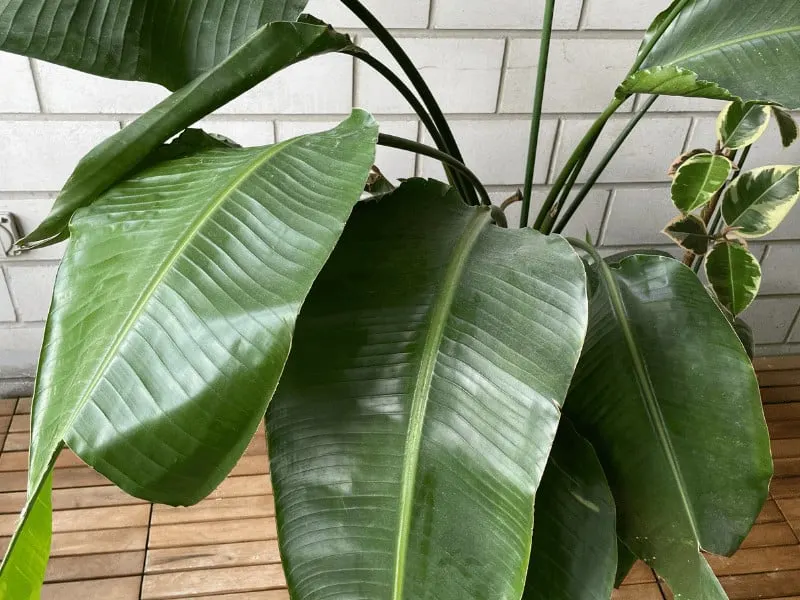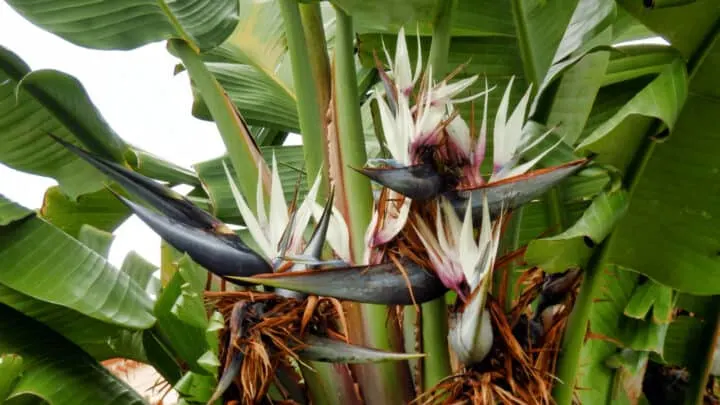The ultimate Strelitzia nicolai care guide. I have had mine for over two years and recently returned it to health. Here is what you need to know.
Takeaways
| Species | Strelitzia nicolai |
| Synonyms | Giant Bird of Paradise,Natal Wild Banana,Wild Strelitzia |
| Family | Strelitziaceae |
| Genus | Strelitzia |
| Growth | Clumping, evergreen |
| Height | 30.0 feet |
| Width | 10.0 feet |
| Soil | Well-draining soil mix |
| Watering | Every 7-14 days |
| Light | Bright indirect |
| Temperature | Min: 60.0°F (16.0°C), Max: 80°F (27°C) |
| Humidity | Min: 50.0%, Max: 70.0% |
| Fertilizer | Every 14 days |
| Propagation | Stem cuttings, layering |
| Toxicity | Toxic to cats, dogs, and moderatly toxic to humans |
Strelitzia nicolai Plant

Another Bird of Paradise plant is the Strelitzia nicolai. This shrub is nicknamed White Bird of Paradise.
This is due to the flower color distinguishing it from the Strelitzia reginae.
According to the University of Florida, the Strelitzia nicolai is also a native to Southern Africa. It’s very similar to the Strelitzia reginae in terms of appearance.
The main difference is that Bird of Paradise’s blooms are white.
Interestingly, this herbaceous perennial is a cousin of the banana! This plant has also been nicknamed the Wild Banana Tree because of this relation.
More specifically, this plant’s leaves resemble a banana tree’s.
Table of Contents
Strelitzia nicolai Care
Strelitzia Nicolai grows best in slightly acidic, well-draining, rich soils. They do best in bright light or full sun to partial shade. These shrubs like high humidity and prefer temperatures between 60-80℉ (16-27℃). Water your plant once its soil has dried 50%. Feed it regularly from spring to summer.

Soil
White Bird of Paradise needs rich, well-draining soil. Slightly acidic soil pH is preferred. Clay, sandy, or loamy soil types are recommended. General-purpose potting soils are suitable but should be mixed with a decent helping of perlite. This will increase the soil’s drainage properties.
Strelitzia Nicolai is a shrub that likes to be planted in a light soil. Rich soils are most beneficial.
Ideal soils for these large tropical plants include loamy, sandy, or clay types. As for pH levels, slightly acidic soils are preferential for White Bird of Paradise.
One of the most important soil characteristics these plants require is drainage. Strelitzia Nicolai prefers moist but well or free-draining soil.
A good choice for this plant is general-purpose potting soil. For added drainage, it is recommended you mix in a good amount of perlite.
Light
This shrub should ideally be kept in a place with partial to full sun. If kept indoors, moderate to bright light is best. However, too much direct sunlight can be harmful to the plant. Dark spots on your Strelitzia Nicolai’s leaves indicate sun scorching.
White Bird of Paradise enjoys its fair share of sunlight. It does well in spots with medium to bright light exposure.
However, it grows best when kept in a spot with access to bright light. Partial shade to full sun is recommended.
Caution must be taken, however, as too much sun can be a problem. Strelitzia nicolai’s leaves can become scorched and damaged.
Sun scorching can be seen as dark spots on your plant’s leaves.
Watering
Strelitzia Nicolai should be kept moderately moist but not soggy. Only water this plant once 50% of its soil has dried. Too much watering will result in a plant having brown, crispy leaves or root rot. Not enough water will result in your plant’s leaves yellowing.
White Bird of Paradise plants enjoys moderately moist soil. Although, they should not be left to sit in waterlogged soil.
Their soil should be left to dry out slightly in between watering sessions. Only water your White Bird of Paradise when 50% of its soil has dried.
Too much water will likely result in root rot.
These shrubs have a moderate tolerance to drought. They’ll tell you through their leaves if they aren’t receiving their water requirement.
The outermost leaves on your Strelitzia Nicolai will begin to yellow. Overwatering often will result in brown, crisp leaves.
Temperature
White Bird of Paradise plants have a slight tolerance for cold temperatures. For best results, keep this shrub in temperatures between 60-80℉ (16-27℃) . Ideally, Strelitzia Nicolai should be protected from frost. However, they may recover slowly from minor frost damage.
As a South African native, the Strelitzia Nicolai is considered a tropical shrub. That said, it is not hard to believe that these plants do better in average to warm temperatures.
Ideally, White Bird of Paradise should be kept in temperatures between 65℉ and 80℉ (18℃ and 27℃).
These shrubs are somewhat hardy and have a slight tolerance for cold temperatures. However, it is recommended that you protect your plant from these unfavorable conditions.
Strelitzia Nicolai plants are also capable of recovering from frost damage. Although, this is a slow process.
The plant is recovery depends on whether the frost has damaged the plant’s roots or not.
Humidity
Strelitzia Nicolai plants love humidity. It is recommended that your mist this shrub regularly to increase the humidity level around it. Misting will also help to clean any dust build-up on the plant’s foliage.
Humidity is an important aspect of care for White Bird of Paradise. These perennial shrubs enjoy higher humidity levels.
It is recommended that you mist your Strelitzia Nicolai occasionally.
Not only will misting your plant increase the humidity level around it. It’ll also help in removing dust from its foliage.
Fertilizer
For best results, fertilize your Strelitzia Nicolai once every two to three weeks. Do so only in spring to summer. Do not feed this shrub in winter as it enters a state of dormancy. Too much fertilizer may result in burning the plant’s roots. A general-purpose fertilizer is recommended.
These large shrubs are big feeders. They do well with being fertilized regularly during their growing period.
Although they like to eat, too much fertilizer can burn your White Bird of Paradise roots. A general-purpose fertilizer may be used.
Feed your Strelitzia nicolai once bi-or tri-weekly from spring through summer for best results. Avoid fertilizing this shrub during the autumn.
It would help if you didn’t feed your White Bird of Paradise during the winter.
This is when the plant will enter a state of dormancy and will not be able to use the fertilizer.
Growth
White Bird of Paradise plants can reach up to 30 feet (9 meters). They grow broad leaves measuring up to 6 feet (1.8 meters) long. Their overall spread can be up to 11 feet (3.5 meters). These shrubs produce elegant white flowers from dark green, grey, or black spathes.
Strelitzia Nicolai shrubs are large, elegant plants. They are one of the larger variants in the Strelitzia family.
Because of their larger size, these shrubs have also been nicknamed the Giant White Bird of Paradise.
White Bird of Paradise plants have woody stems that grow 30 feet tall (9 meters). With this height comes an excellent spread of clumps.
It is not uncommon for their spread to reach as far as 11 feet (3.5 meters).
The leaves of the Strelitzia Nicolai resemble the broad banana tree leaves. The foliage is greyish-green in color.
Growing on top of the plant’s stems, its leaves take a fan-like arrangement. Each leaf can measure up to 6 feet (1.8 meters) long.
Although their foliage color resembles their relative Strelitzia reginae, its flowers are not. The Strelitzia Nicolai’s flowers are one of the main characteristics that differentiate it from its smaller but similar relative.
White Bird of Paradise blooms white flowers as its common name suggests.
The beak-like spathe from which the flowers emerge is dark green, dark grey, or black.
Potting
These shrubs can be kept as potted plants, although they need a large space to grow. Repot your Strelitzia Nicolai once a year until it has matured. When mature, only repot it with a 3-year gap. Repotting this plant when it is in its blooming cycle is not recommended.
White Bird of Paradise shrubs make excellent décor plants due to their showy flowers. The one drawback, though, is their size.
If you wish to keep this plant as a houseplant, it will need a large area to grow in.
White Bird of Paradise plants must typically be repotted every three years. However, it is recommended they you repot these shrubs once a year.
Repotting them more regularly means you can check the health of their roots more often.
Once your Strelitzia Nicolai has reached an age of maturity, it is best to repot it less frequently. These shrubs are thought to be more likely to bloom if they are root or pot-bound.
Repotting your White Bird of Paradise during this time may interrupt its blooming cycle.
Pruning
Prune White Bird of Paradise plant regularly. Use clean, sharp, gardening shears to prune this shrub. Remove spent flowers, yellowing, damaged, or dead leaves as they appear. Doing so will allow the plant to revert its energy to its healthy leaves.
As these plants are so large, keeping all their leaves looking great takes a lot of energy. Therefore, when you see a yellowing, damaged, or dead leaf, prune it immediately.
Removing the unhealthy leaves as they appear will allow your Strelitzia Nicolai to focus on its good leaves. This will aid in keeping the rest of your plant’s leaves looking their best.
The same should be done with spent flowers. Remove the dying or dead flowers as soon as possible.
It is also recommended that when you are pruning your White Bird of Paradise, you use sharp, clean gardening shears.
Strelitzia Nicolai Propagation
It’s best to propagate your White Bird of Paradise through division. Although, propagation is also possible through the use of seeds and suckers. In some cases, this plant may even self-propagate. Do not divide your plant’s rhizome too often, as crowded clumps will likely produce more flowers.
These gorgeous shrubs are easily propagated. Possible methods of propagation include seeds, division, and suckers.
In some cases, the Strelitzia Nicolai may even self-propagate!
Although it is possible, propagating this plant through seeds is not recommended. It’s because planting from seed is a lengthy process.
The division is the best method of propagating White Bird of Paradise. To avoid unnecessary stress, divide your plant’s rhizome during your repotting sessions.
Do not divide your plant’s rhizome too often. Strelitzia Nicolai clumps that are more crowded are known to produce more flowers.
Common Problems with Strelitzia Nicolai
White Bird of Paradise plants are fairly resistant to pests and diseases. The most common killer of these extravagant plants is fungus or rot.
These diseases are typically due to overwatering. In some cases, inadequate soil types or drainage is the problem.
Minor, non-threatening pests such as spider mites, mealybugs, or aphids may be seen on your Strelitzia Nicolai.
These pests are easy to get rid of and won’t cause much harm to your Strelitzia Nicolai.
Cleaning your plant’s foliage with insecticidal soap is recommended to control these pest problems.
Frequently Asked Questions about Strelitzia Nicolai Care
At what age do White Bird of Paradise plants produce their first flowers?
These shrubs are likely only to start producing flowers once they have fully matured. Some plants may begin flowering at three years. Others may only flower after about six years.
Is the Strelitzia Nicolai considered toxic?
White Bird of Paradise plants are considered toxic. Although symptoms are mild, ingestion of any plant parts should be avoided. Keep this shrub out of the reach of kids and pets.
Do White Bird of Paradise plants purify the air?
White Bird of Paradise plants are considered somewhat air-purifying plants. Although they are not the most effective air purifiers, they are known to improve the overall quality of the air around them.
Why are my White Bird of Paradise plant’s leaves splitting?
Split leaves on White Bird of Paradise plants are a natural occurrence. Due to the size of their leaves, scientists believe they split to reduce wind drag. Therefore, you shouldn’t worry much about split leaves!
Conclusion
Strelitzia nicolai is a truly magnificent plant that is fairly easy to care for and sets a statement inside and outside.
Aside from their elegant beauty, these shrubs are also easy to care for.
They are fairly forgiving plants and oftentimes tell you if something’s not right!

Daniel has been a plant enthusiast for over 20 years. He owns hundreds of houseplants and prepares for the chili growing seasons yearly with great anticipation. His favorite plants are plant species in the Araceae family, such as Monstera, Philodendron, and Anthurium. He also loves gardening and is growing hot peppers, tomatoes, and many more vegetables.


